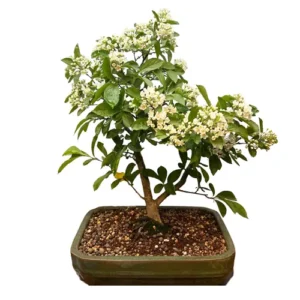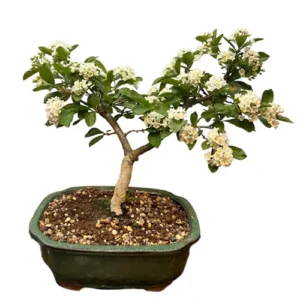Hamamelis
Witch Hazel Bonsai
Native to East Canada and the North East of the United States. This deciduous shrub is renowned for its numerous medicinal properties. As a Bonsai it boasts yellow flowers that bloom in the Autumn and winter and hazelnut-shaped fruit that is seeded.
Witch Hazel Bonsai Care Tips
Placement
Witch Hazel is an outdoor bonsai that requires full sun or some partial shade in warmer climates. While this plant is hardy to below-zero temperatures it should be protected from drier winds.
Watering
Witch Hazel is not a drought-resistant species. It requires a considerable amount of water and should be watered thoroughly the moment the top layer is dry. Humidity is best for its root ball without waterlogging the plant.
Feeding & Fertilising
During the growing season, feed your Witch Hazel every two weeks with liquid or organic feed.
Pruning & Wiring
Pruning your bonsai is important not only to create or maintain an aesthetic style but to also ensure optimal health. Witch Hazel should be pruned to give the desired shape. Pinch lightly throughout the growing season to develop the crown.
Witch Hazel are not a species that is commonly wired, yet if doing so, it should take place before sprouting. We recommend using wires with a thickness that matches the thickness of the branch: if the wire you choose is too thick you will damage the bark. If it is too thin, it won’t be effective.
Repotting
Repotting your tree is an important way to provide a fresh and suitable soil mix and ensure appropriate root health. Your Witch Hazel should be repotted every two to three years at the start of Spring. The ideal time is just before the new buds appear.
Trees that are ready for repotting will require root pruning, a suitable new pot and appropriate soil mix.
When repotting, do not cut back the root mass by a large amount, and choose a well-draining soil mix that has a neutral or slightly higher PH value of 5-6 but not over 7. We tend to use a mixture of different speciality bonsai soils on our trees. Every species is different so please contact us for free soil-mix advice or to take advantage of our repotting service.
Bonsai trees aren’t only magnificent additions to an indoor oasis, they are more than capable of standing out in any garden. Many Bonsai species are incredibly hardy and withstand nature’s colder and damper turns with aplomb making them worthwhile outdoor plants. We have an extensive library of care guides for outdoor bonsai trees. It’s not about selecting the perfect bonsai, it’s about selecting the perfect bonsai for you.
Witch Hazel Bonsai - Typical Queries
Can Witch Hazel bonsai get pests and diseases?
Though typically resistant to pests, Witch Hazel if over fertilised can bring on aphids and scale. Keep an eye out for caterpillars as these are a favourite food of the Witch Hazel.
Does Witch Hazel have medicinal propeties?
Hamamelis contain a number of medicinal compounds. Both tannins and flavonoids found inside have anti-inflammatory, anti-septic, astringent and hemostatic properties.
Can you keep a Witch Hazel bonsai indoors?
It is not advised to grow a Witch Hazel Bonsai indoors as it requires plenty of full sun despite being sensitive to dry wind. Shade is likely to get this plant straggly.





















